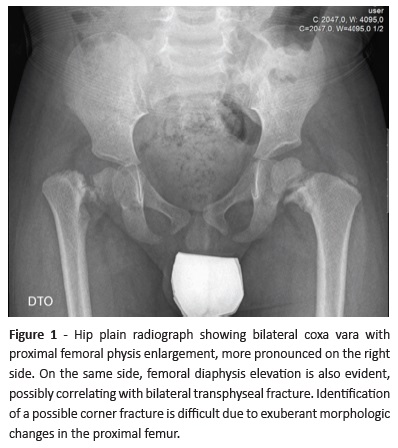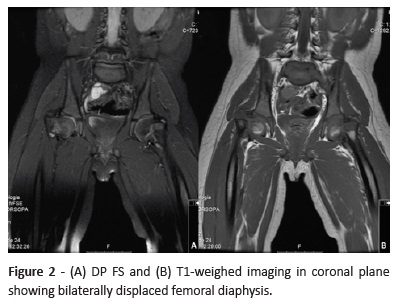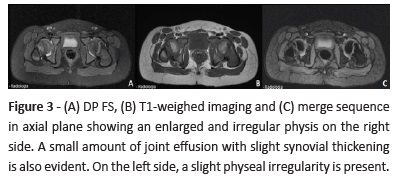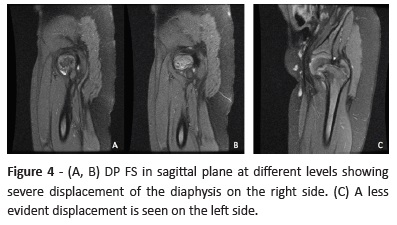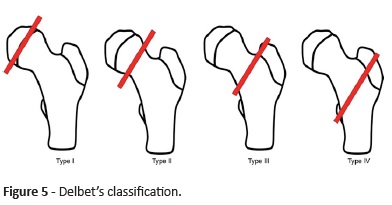Serviços Personalizados
Journal
Artigo
Indicadores
-
 Citado por SciELO
Citado por SciELO -
 Acessos
Acessos
Links relacionados
-
 Similares em
SciELO
Similares em
SciELO
Compartilhar
Nascer e Crescer
versão impressa ISSN 0872-0754versão On-line ISSN 2183-9417
Nascer e Crescer vol.28 no.4 Porto dez. 2019
https://doi.org/10.25753/BirthGrowthMJ.v28.i4.14702
CASE REPORTS | CASOS CLÍNICOS
Bilateral transphyseal fractures: is there more than we can see?
Fraturas transfisárias bilaterais: existe mais para além do que podemos ver?
Maria Ana SerradoI, Natacha AbreuI, Pedro Paulo MendesII, Pedro AlvesII
I Department of Radiology, Hospital Dr. Nélio Mendonça. 9000-177 Funchal, Portugal. m_serrado@hotmail.com; natachanobregaabreu@gmail.com
II Department of Pediatric Radiology, Hospital Dona Estefânia, Centro Hospitalar de Lisboa Central. 1169-045 Lisboa, Portugal. pedrpaulmend@gmail.com; tojais.pedro48@gmail.com
Endereço para correspondência | Dirección para correspondencia | Correspondence
ABSTRACT
Introduction: Claudication is a common complaint in children, and diagnosis of underlying etiologies is challenging. In toddlers, the most likely causes of gait alterations can be divided into five groups: inflammatory/infectious; neurologic; developmental/congenital; neoplastic; and post-traumatic.
Case report: Here in is reported the case of a three-year-old boy with claudication diagnosed with bilateral proximal femoral transphyseal fractures by plain radiograph and magnetic resonance imaging.
Conclusion: When a non-ambulatory child presents with femur fractures, clinical history should address specific questions to determine whether the explanation put forth can reasonably explain the injury. Prompt diagnosis is key for early treatment and prevention of potential complications.
Keywords: claudication; magnetic resonance; non-acidental trauma; radiography
RESUMO
Introdução: A claudicação é uma queixa frequente em crianças e o diagnóstico das etiologias associadas é desafiante. Em crianças pequenas, as causas mais prováveis de alterações da marcha podem ser divididas em cinco grupos: inflamatórias/infecciosas; neurológicas; desenvolvimentais/congénitas; neoplásicas; e pós-traumáticas.
Caso clínico: É descrito o caso de um menino de três anos com claudicação, diagnosticado com fratura bilateral das fises femorais proximais através de radiografia e ressonância magnética.
Conclusão: Quando uma criança que ainda não anda se apresenta com uma fratura do fémur, deve ser detalhada a história clínica e procurar responder a questões que determinem se o mecanismo descrito poderá justificar tal lesão.
O diagnóstico célere é fundamental, de forma a permitir o tratamento precoce e prevenção de potenciais complicações.
Palavras-chave: claudicação; radiografia; ressonância magnética; trauma não acidental
Introduction
Claudication is a common complaint in children, and diagnosis of underlying etiologies is challenging.
A large range of causes can be associated with abnormal gait. As such, a systematic approach according to claudication pattern and age of onset is recommended.1
Three age groups are classically considered: toddlers - one to three years old (learning to walk); school-aged children - four to ten years old (with a more mature gait); and adolescents - older than eleven years old (with an adult gait pattern).
Diagnosis of abnormal gait is particularly difficult in toddlers for two reasons. On the one hand, evaluation is almost exclusively focused on physical examination, as clinical history is unclear and mostly relies on the subjective opinion of parents and caregivers. On the other hand, the immature gait pattern typically found in young children (characterized by broad-base and increased flexion of the hips and knees) makes it difficult to distinguish between what is abnormal and what is part of a learning gait process. Additionally, unbalanced gait is elicited by arm positioning alongside the body, with extended elbows.
In toddlers, the most likely causes of gait alterations can be divided into five groups: inflammatory/infectious disorders (transient synovitis, septic arthritis, juvenile rheumatoid arthritis); neurological disorders (cerebral palsy, muscular dystrophy); developmental/ congenital disorders (developmental dysplasia of the hip, coxa vara); neoplastic disorders (osteoid osteoma, leukemia); and post-traumatic disorders.1
The diagnostic approach to claudication should include a thorough characterization of pain intensity and pattern. Clinical findings, as fever, can also guide the differential diagnosis. Several laboratory findings are associated with specific conditions − for instance, serum creatinine phosphokinase can be linked to muscular dystrophy. Associated pathologies and family history may also guide the differential diagnosis.
Herein is reported the case of a three-year-old boy with claudication diagnosed with bilateral proximal femoral transphyseal fractures through plain radiograph and magnetic resonance imaging (MRI).
Case report
A three-year-old boy from Guinea Bissau was referred to our Institution with suspected aseptic necrosis or osteoarthritis of the right femoral head.
He presented with gait claudication with 18 months of evolution, with periods when he was not able to walk or became easily fatigued, not clearly related to a traumatic event. The parents briefly referred to a fall 18 months before, without giving it too much attention. At the time, the boy developed a febrile episode that resolved with antibiotic treatment and physiotherapy. On physical examination, the only relevant event was pain upon passive mobilization of the right hip. An extensive laboratory workup was performed. Hemoglobin and sedimentation rate were slightly altered: 10.9x10 g/L (normal range: 11.5−13.5 g/L) and 23 mm/h (normal: <11), respectively. Hip plain radiograph showed bilateral coxa vara with enlargement of the proximal femoral physis, more pronounced on the right side, where a lateral dislocation of the femoral diaphysis was also evident (Figure 1). These findings were consistent with physeal fracture.
MRI confirmed coxa vara and depicted additional bilateral transphyseal fractures (Figures 2, 3 and 4). These findings were consistent with Salter-Harris’ classification type I and Delbet’s classification type I fracture. Physis enlargement was evident on the right side, as was a small amount of joint effusion and slight synovial thickening. Diaphysis was laterally dislocated, with upper and outer deviation. On the left side, only a slight physis irregularity was observed, with less evident upper and outer diaphysis deviation. No fracture lines were identified.
These findings suggested a diagnosis of bilateral transphyseal fractures, with potentially traumatic non-union segments. Given the unclear context of the traumatic episode and uncommon radiological findings, a full skeletal survey was recommended to exclude non-accidental traumatic lesions. However, the child was subsequently lost to follow-up.
Discussion
Fractures of the femur head and neck in healthy children are rare, accounting for less than 1% of all pediatric fractures.
Proximal femoral fractures can be divided into two groups: traumatic and non-traumatic. The most common cause is a high-energy trauma (motor vehicle accidents, falls from a height).2-4 In 30% of these cases, other injuries are present.2 Non-traumatic causes include prior bone deformation, bone tumors, stress fractures, “battered child syndrome”, or spontaneous onset.2,3
In children under the age of two, particularly when not yet walking, fractures are highly suggestive of child abuse. Children younger than 18 months with femur fractures are more likely to have experienced abuse than accidental trauma. In non-ambulatory children, injuries of the proximal femoral physis are less common than distal epiphyseal injuries, but also highly correlated with abuse.5
Scott et al. described the case of a four-year-old girl with a bilateral femoral neck fracture associated with multiple pelvic ring fractures.6 The report emphasized that high-energy trauma was required to produce bilateral femoral neck fractures. In the present case, the bilateral presentation, unclear clinical history, and need for additional clinical information after 18 months of claudication led to the recommendation of a full skeletal survey to detect non-accidental trauma.
The first-line imaging modality to diagnose femoral fractures is plain radiograph. Orthogonal views, typically anteroposterior and lateral radiographs of the entire femur, including hip and knee, should be obtained.5 MRI may be indicated, depending on fracture type and location, and risk of complications. MRI protocols typically include fluidand cartilage-sensitive sequences and T1-weighted images to evaluate bone marrow signal.5 Computed tomography may help characterize possible pathologic lesions and in pre-operative surgery planning in complex fracture cases.5 Ultrasound may be indicated in infants with suspected physeal injuries and/or epiphyseal separations.5
Femoral neck fractures are classified according to the radiographic Delbet’s classification (Figure 5), which is important to determine treatment and prognosis.4 Type I fractures are transepiphyseal separations, with or without dislocation of the femoral head from the acetabulum. Type II corresponds to transcervical, type III to cervicotrochateric, and type IV to intertrochateric fractures. Type I fracture is the least common and type II the most common type.2,7
Ancillary findings, such as metaphyseal irregularities with “corner fracture” and new periosteal bone formation, can also be observed.6
Due to the rarity of these fractures, the surgical approach is individualized and a universal treatment protocol is not established.2,3 Conservative treatment may be adequate for undisplaced fractures, while displaced fractures should be reduced and fixed.2,4
When treating proximal femoral fractures, stability is more important than sparing the growth plate.2
A therapeutic intervention 48 hours after a traumatic event may increase the risk of complications, such as femoral head necrosis, particularly in Delbet type I fractures.3
Potential complications associated with femoral fractures include avascular necrosis, non-union, mal-union, premature closure of the physis, and coxa vara, all of which should be considered. Treatment-related complications increase morbidity associated with these fractures and may include infections, chondrolysis, and skin problems.2,4
Considering prognosis, type I fractures have the highest complication rate and type IV the most favorable outcome. Delbet type I fractures without dislocation have a better prognosis than those with dislocation and young children typically have better outcomes than older counterparts.7
Brown et al. described the case of a ten-month-old child with transphyseal femoral neck fracture with a seven-day delay in diagnosis.7 Despite the delay, a favorable outcome was achieved with appropriate treatment. In the present case, the diagnostic delay was significantly greater and precluded adequate treatment. Given the time elapsed from the traumatic event, the child already displayed significant morphologic changes in both hips at the age of three.
Conclusion
When a non-ambulatory child presents with femur fractures, careful medical history should be retrieved to determine whether the «explanation put forth can reasonably explain the injury, and the possibility of child abuse should be specifically addressed.
Among several types of femoral fractures, Delbet’s classification type I may be difficult to diagnose in infants through plain radiograph, as the femoral head is not yet ossified.
Prompt diagnosis is key so that early treatment can be initiated, and potential complications arising from the lesion and treatment prevented.
REFERENCES
1. Santili C, Júnior WL, Goiano Ede O, Lins RA, Waisberg G, Braga Sdos R, et al. LIMPING IN CHILDREN. Rev Bras Ortop. 2015; 44:290-8. doi: 10.1016/S2255-4971(15)30156-7 . [ Links ]
2. Bimmel R, Bakker A, Bosma B, Michielsen J. Paediatric hip fractures: a systematic review of incidence, treatment options and complications. Acta Orthop Belg. 2010; 76:7-13. [ Links ]
3. Hajdu S, Oberleitner G, Schwendenwein E, Ringl H, Vécsei V. Fractures of the head and neck of the femur in children: an outcome study. Int Orthop. 2011; 35:883-8. doi: 10.1007/s00264-010-1039-z . [ Links ]
4. Flynn JM, Wong KL, Yeh GL, Meyer JS, Davidson RS. Displaced fractures of the hip in children. Management by early operation and immobilisation in a hip spica cast. J Bone Joint Surg Br. 2002; 84:108-12. [ Links ]
5. Scott B, Taylor B, Shung JR, Nimityongskul P. Bilateral femoral neck fractures associated with complex pelvic ring injuries in a pediatric patient: a case report. J Pediatr Orthop B. 2017; 26:350-357. doi: 10.1097/BPB.0000000000000375 . [ Links ]
6. Vuillermin C, Bixby SD. Radiologic Evaluation of Femur Fractures. In: Hedequist D, Heyworth B, editors. Pediatric Femur Fractures. Boston: Springer; 2016 .https://doi.org/10.1007/978-1-48997986-5_2 . [ Links ]
7. Brown MJ, Ferrick MR. Transphyseal Femoral Neck Fracture in a Twenty-Month Old Male Child. Open Orthop J. 2016; 10:56-61. doi: 10.2174/1874325001610010056 . [ Links ]
Endereço para correspondência | Dirección para correspondencia | Correspondence
Maria Ana Serrado
Department of Radiology
Hospital Dr. Nélio Mendonça
Av. Luís de Camões 6180
9000-177 Funchal
Email: m_serrado@hotmail.com
Received for publication: 25.11.2018
Accepted in revised form: 28.03.2019













